Determination of the Temperature Development in a Borehole Heat Exchanger Field Using Distributed Temperature Sensing
Abstract
1. Introduction
1.1. Thermal Properties
1.2. District Heating Cooling Network of “Lagarde Campus”
2. Monitoring Concept
2.1. Test Site
2.2. Distributed Temperature Sensing
3. First Results
4. Discussion
4.1. Positioning of the Fiber Optic Cable
4.2. Interpretation of the Geological Surroundings
4.3. Comparison with Exisiting Technology and Outlook for Further Research
5. Conclusions
- The usage of distributed temperature sensing via fiber optic cables is a good method for determining ground temperatures independently of the progress of the construction of the BHE field.
- Installation of the fiber optics outside of the BHEs is recommended, as this provides more sensitive and less faulty data. The collected data reflect the surrounding borehole and lithology much better.
- An influence of the geological units and the groundwater can be seen in the case of the BHE field in Bamberg. Larger differences in thermal conductivity amplify this observation.
Author Contributions
Funding
Data Availability Statement
Acknowledgments
Conflicts of Interest
Nomenclature
| (5G)DHC | (Fifth generation) district heating cooling |
| BHE | Borehole heat exchanger |
| DTS | Distributed temperature sensing |
| eGRT | Enhanced (geo)thermal response test |
| GWL | Groundwater level |
| P-T | Pressure–temperature |
| PE | 100-RC Polyethylene, resistant to cracks |
| TRT | Thermal response test |
References
- Luo, J.; Rohn, J.; Xiang, W.; Bertermann, D.; Blum, P. A review of ground investigations for ground source heat pump (GSHP) systems. Energy Build. 2016, 117, 160–175. [Google Scholar] [CrossRef]
- Wilke, S.; Menberg, K.; Steger, H.; Blum, P. Advanced thermal response tests: A review. Renew. Sustain. Energy Rev. 2020, 119, 109575. [Google Scholar] [CrossRef]
- Acuña, J.; Palm, B. Distributed thermal response tests on pipe-in-pipe borehole heat exchangers. Appl. Energy 2013, 109, 312–320. [Google Scholar] [CrossRef]
- Popov, Y. Theoretical models of the method of determination of the thermal properties of rocks on the basis of movable sources. Geol Razved (Geol Prospect.) 1983, 9, 97–105. [Google Scholar]
- Popov, Y.; Tertychnyi, V.; Romushkevich, R.; Korobkov, D.; Pohl, J. Interrelations between thermal conductivity and other physical properties of rocks: Experimental data. In Thermo-Hydro-Mechanical Coupling in Fractured Rock; Birkhäuser: Basel, Switzerland, 2003; pp. 1137–1161. [Google Scholar] [CrossRef]
- Popov, Y.A.; Pribnow, D.F.; Sass, J.H.; Williams, C.F.; Burkhardt, H. Characterization of rock thermal conductivity by high-resolution optical scanning. Geothermics 1999, 28, 253–276. [Google Scholar] [CrossRef]
- Bertermann, D.; Schwarz, H. Laboratory device to analyse the impact of soil properties on electrical and thermal conductivity. Int. Agrophysics 2017, 31, 157–166. [Google Scholar] [CrossRef]
- Clauser, C.; Huenges, E. Thermal Conductivity of Rocks and Minerals. Rock Phys. Phase Relat. 1995, 3, 105–126. [Google Scholar]
- Franz, C.; Schulze, M. Bestimmung thermischer Eigenschaften der Gesteine des Unteren und Mittleren Buntsandsteins. Grundwasser 2016, 21, 47–58. [Google Scholar] [CrossRef]
- Long, M.; Murray, S.; Pasquali, R. Thermal conductivity of Irish rocks. Ir. J. Earth Sci. 2018, 36, 63–80. [Google Scholar] [CrossRef]
- VDI 4640-5; Thermal Use of the Underground—Part 5: Thermal-Response-Test (TRT). VDI: Düsseldorf, Germany, 2020.
- VDI 4640-1; Thermal Use of the Underground—Part 1: Fundamentals, Approvals, Environmental Aspects. VDI: Düsseldorf, Germany, 2010.
- Bertermann, D.; Klug, H.; Morper-Busch, L. A pan-European planning basis for estimating the very shallow geothermal energy potentials. Renew. Energy 2015, 75, 335–347. [Google Scholar] [CrossRef]
- Bertermann, D.; Bialas, C.; Morper-Busch, L.; Klug, H.; Rohn, J.; Stollhofen, H.; Psyk, M.; Jaudin, F.; Maragna, C.; Einarsson, G.M.; et al. ThermoMap—An Open-Source Web Mapping Application for Illustrating the very Shallow Geothermal Potential in Europe and selected Case Study Areas. In Proceedings of the European Geothermal Congress, Pisa, Italy, 3–7 June 2013. [Google Scholar]
- Koubikana Pambou, C.H.; Raymond, J.; Lamarche, L. Improving thermal response tests with wireline temperature logs to evaluate ground thermal conductivity profiles and groundwater fluxes. Heat Mass Transf. 2019, 55, 1829–1843. [Google Scholar] [CrossRef]
- Li, P.; Dou, B.; Guan, P.; Zheng, J.; Tian, H.; Duan, X. Thermophysical and Heat Transfer Characteristics Based on Thermal Response and Thermal Recovery Test of a U-Pipe Borehole Heat Exchanger. J. Eng. Thermophys. 2023, 32, 117–137. [Google Scholar] [CrossRef]
- Aranzabal, N.; Martos, J.; Steger, H.; Blum, P.; Soret, J. Temperature measurements along a vertical borehole heat exchanger: A method comparison. Renew. Energy 2019, 143, 1247–1258. [Google Scholar] [CrossRef]
- Aranzabal, N.; Martos, J.; Stokuca, M.; Mazzotti Pallard, W.; Acuña, J.; Soret, J.; Blum, P. Novel instruments and methods to estimate depth-specific thermal properties in borehole heat exchangers. Geothermics 2020, 86, 101813. [Google Scholar] [CrossRef]
- Martos, J.; Montero, Á.; Torres, J.; Soret, J.; Martínez, G.; García-Olcina, R. Novel wireless sensor system for dynamic characterization of borehole heat exchangers. Sensors 2011, 11, 7082–7094. [Google Scholar] [CrossRef]
- Meyer, J.; Zeh, R.; Schmid, M.; Stockinger, V. Innovative Wärmeversorgung im innerstädtischen Quartier: Wärme-und Monitoringkonzept; HAWK, Hochschule für angewandte Wissenschaft und Kunst Hildesheim/Holzminden/Göttingen-Bibliothek: Hildesheim, Germany, 2023. [Google Scholar] [CrossRef]
- Sharma, W.S.; Seki, A.; Angel, S.; Garvis, D. Field testing of an optical fiber temperature sensor in a geothermal. Geothermics 1990, 19, 285–294. [Google Scholar] [CrossRef]
- Fujii, H.; Okubo, H.; Itoi, R. Thermal response tests using optical fiber thermometers. In Proceedings of the GRC 2006 Annual Meeting: Geothermal Resources-Securing Our Energy Future, San Diego, CA, USA, 10–13 September 2006; pp. 545–551. [Google Scholar]
- Fujii, H.; Okubo, H.; Nishi, K.; Itoi, R.; Ohyama, K.; Shibata, K. An improved thermal response test for U-tube ground heat exchanger based on optical fiber thermometers. Geothermics 2009, 38, 399–406. [Google Scholar] [CrossRef]
- Michalski, A.; Klitzsch, N. First field application of temperature sensor modules for groundwater flow detection near borehole heat exchanger. Geotherm. Energy 2019, 7, 37. [Google Scholar] [CrossRef]
- Cultrera, M.; Boaga, J.; Di Sipio, E.; Dalla Santa, G.; De Seta, M.; Galgaro, A. Modelling an induced thermal plume with data from electrical resistivity tomography and distributed temperature sensing: A case study in northeast Italy. Hydrogeol. J. 2017, 26, 837–851. [Google Scholar] [CrossRef]
- Acuña, J. Improvements of U-Pipe Borehole Heat Exchangers; KTH: Stockholm, Sweden, 2010. [Google Scholar]
- Ma, Y.; Zhang, Y.; Cheng, Y.; Zhang, Y.; Gao, X.; Shan, K. A case study of field thermal response test and laboratory test based on distributed optical fiber temperature sensor. Energies 2022, 15, 8101. [Google Scholar] [CrossRef]
- Zeh, R.; Ohlsen, B.; Philipp, D.; Bertermann, D.; Kotz, T.; Jocić, N.; Stockinger, V. Large-Scale Geothermal Collector Systems for 5th Generation District Heating and Cooling Networks. Sustainability 2021, 13, 6035. [Google Scholar] [CrossRef]
- Lang, M. Geologische Karte von Bayern 1:25000 6131 Bamberg Süd; Bayerisches Geologisches Landesamt: Augsburg, Germany, 1970. [Google Scholar]
- Lang, M.; Bader, K. Erläuterungen zur Geologischen Karte von Bayern 1: 25 000 Blatt Nr. 6131 Bamberg Süd; Bayerisches Geologisches Landesamt: Augsburg, Germany, 1970. [Google Scholar]
- Suft, O.; Bertermann, D. One-Year Monitoring of a Ground Heat Exchanger Using the In Situ Thermal Response Test: An Experimental Approach on Climatic Effects. Energies 2022, 15, 9490. [Google Scholar] [CrossRef]
- Cao, D.; Shi, B.; Zhu, H.-H.; Wei, G.; Bektursen, H.; Sun, M. A field study on the application of distributed temperature sensing technology in thermal response tests for borehole heat exchangers. Bull. Eng. Geol. Environ. 2019, 78, 3901–3915. [Google Scholar] [CrossRef]
- Bertermann, D.; Rammler, M. Suitability of Screened Monitoring Wells for Temperature Measurements Regarding Large-Scale Geothermal Collector Systems. Geosciences 2022, 12, 162. [Google Scholar] [CrossRef]
- Menberg, K.; Bayer, P.; Zosseder, K.; Rumohr, S.; Blum, P. Subsurface urban heat islands in German cities. Sci. Total Environ. 2013, 442, 123–133. [Google Scholar] [CrossRef]
- Hemmerle, H.; Ferguson, G.; Blum, P.; Bayer, P. The evolution of the geothermal potential of a subsurface urban heat island. Environ. Res. Lett. 2022, 17, 084018. [Google Scholar] [CrossRef]
- Dalla Santa, G.; Galgaro, A.; Sassi, R.; Cultrera, M.; Scotton, P.; Mueller, J.; Bertermann, D.; Mendrinos, D.; Pasquali, R.; Perego, R.; et al. An updated ground thermal properties database for GSHP applications. Geothermics 2020, 85, 101758. [Google Scholar] [CrossRef]
- Eppelbaum, L.; Kutasov, I.; Pilchin, A.; Eppelbaum, L.; Kutasov, I.; Pilchin, A. Thermal properties of rocks and density of fluids. In Applied Geothermics; Springer: Berlin/Heidelberg, Germany, 2014; pp. 99–149. [Google Scholar] [CrossRef]
- Midttømme, K.; Roaldset, E.; Aagaard, P. Thermal conductivity of selected claystones and mudstones from England. Clay Miner. 1998, 33, 131–145. [Google Scholar] [CrossRef]
- Dalla Santa, G.; Pasquier, P.; Schenato, L.; Galgaro, A. Repeated ETRTs in a Complex Stratified Geological Setting: High-Resolution Thermal Conductivity Identification by Multiple Linear Regression. J. Geotech. Geoenviron. Eng. 2022, 148, 04022007. [Google Scholar] [CrossRef]
- DIN 4023; Geotechnische Erkundung und Untersuchung—Zeichnerische Darstellung der Ergebnisse von Bohrungen und Sonstigen Direkten Aufschlüssen. DIN: Berlin, Germany, 2004.
- Kus, G. Hydrogeologische Karte von Bayern 1:50000 L 6130 Bamberg Blatt 1: Grundlagen; Bayerisches Landesamt für Umwelt: Augsburg, Germany, 2008. [Google Scholar]
- Capozza, A.; De Carli, M.; Zarrella, A. Investigations on the influence of aquifers on the ground temperature in ground-source heat pump operation. Appl. Energy 2013, 107, 350–363. [Google Scholar] [CrossRef]
- Brigaud, F.; Vasseur, G. Mineralogy, porosity and fluid control on thermal conductivity of sedimentary rocks. Geophys. J. 1989, 98, 525–542. [Google Scholar] [CrossRef]
- Alishaev, M.G.; Abdulagatov, I.M.; Abdulagatova, Z.Z. Effective thermal conductivity of fluid-saturated rocks. Eng. Geol. 2012, 135–136, 24–39. [Google Scholar] [CrossRef]
- Soto, M.; Sahu, P.; Faralli, S.; Bolognini, G.; Di Pasquale, F.; Nebendahl, B.; Rueck, C. Distributed temperature sensor system based on Raman scattering using correlation-codes. Electron. Lett. 2007, 43, 862. [Google Scholar] [CrossRef]
- He, H.; Dyck, M.F.; Horton, R.; Li, M.; Jin, H.; Si, B. Distributed temperature sensing for soil physical measurements and its similarity to heat pulse method. Adv. Agron. 2018, 148, 173–230. [Google Scholar] [CrossRef]
- Aranzabal, N.; Martos, J.; Steger, H.; Blum, P.; Soret, J. Novel instrument for temperature measurements in borehole heat exchangers. IEEE Trans. Instrum. Meas. 2018, 68, 1062–1070. [Google Scholar] [CrossRef]
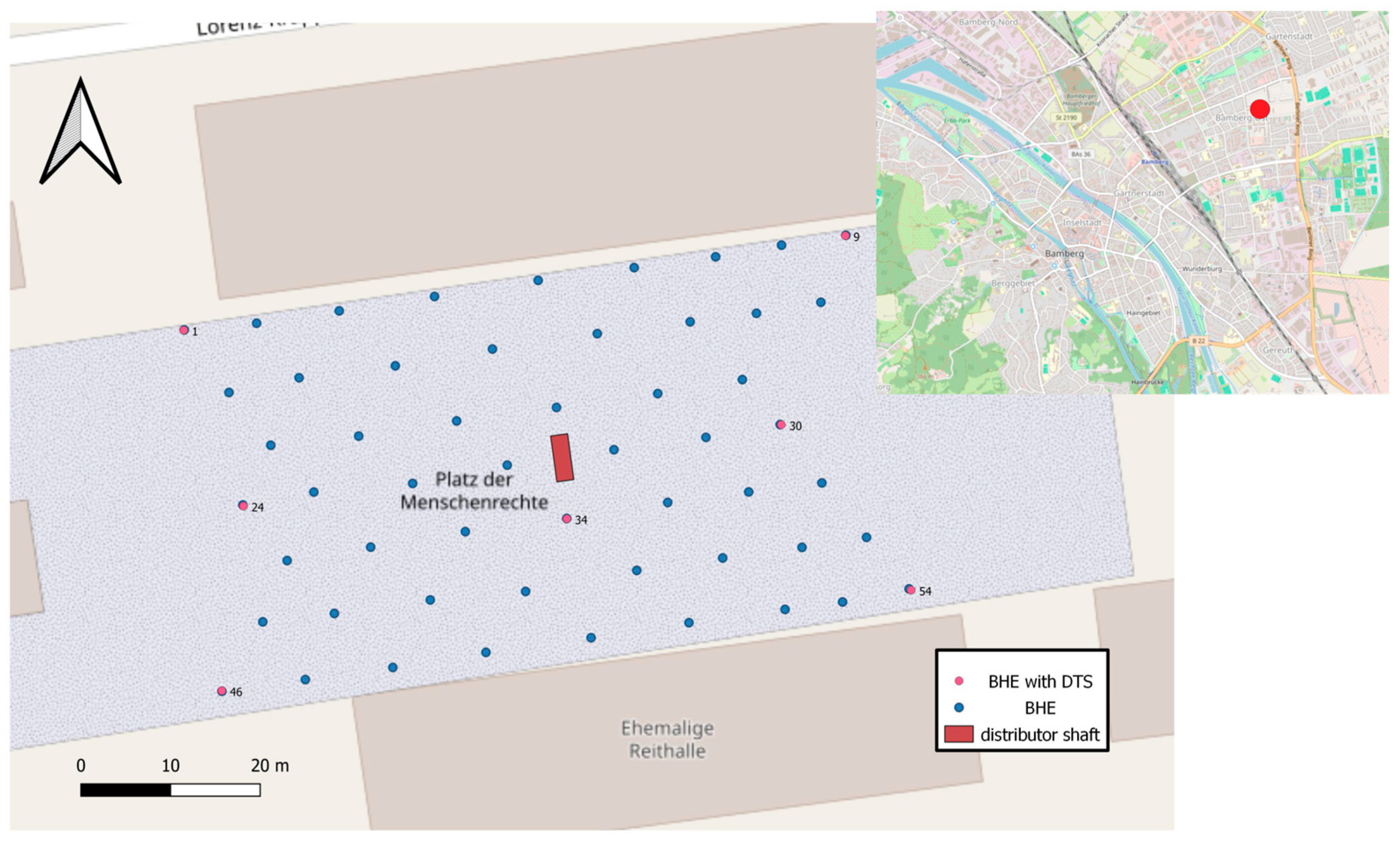
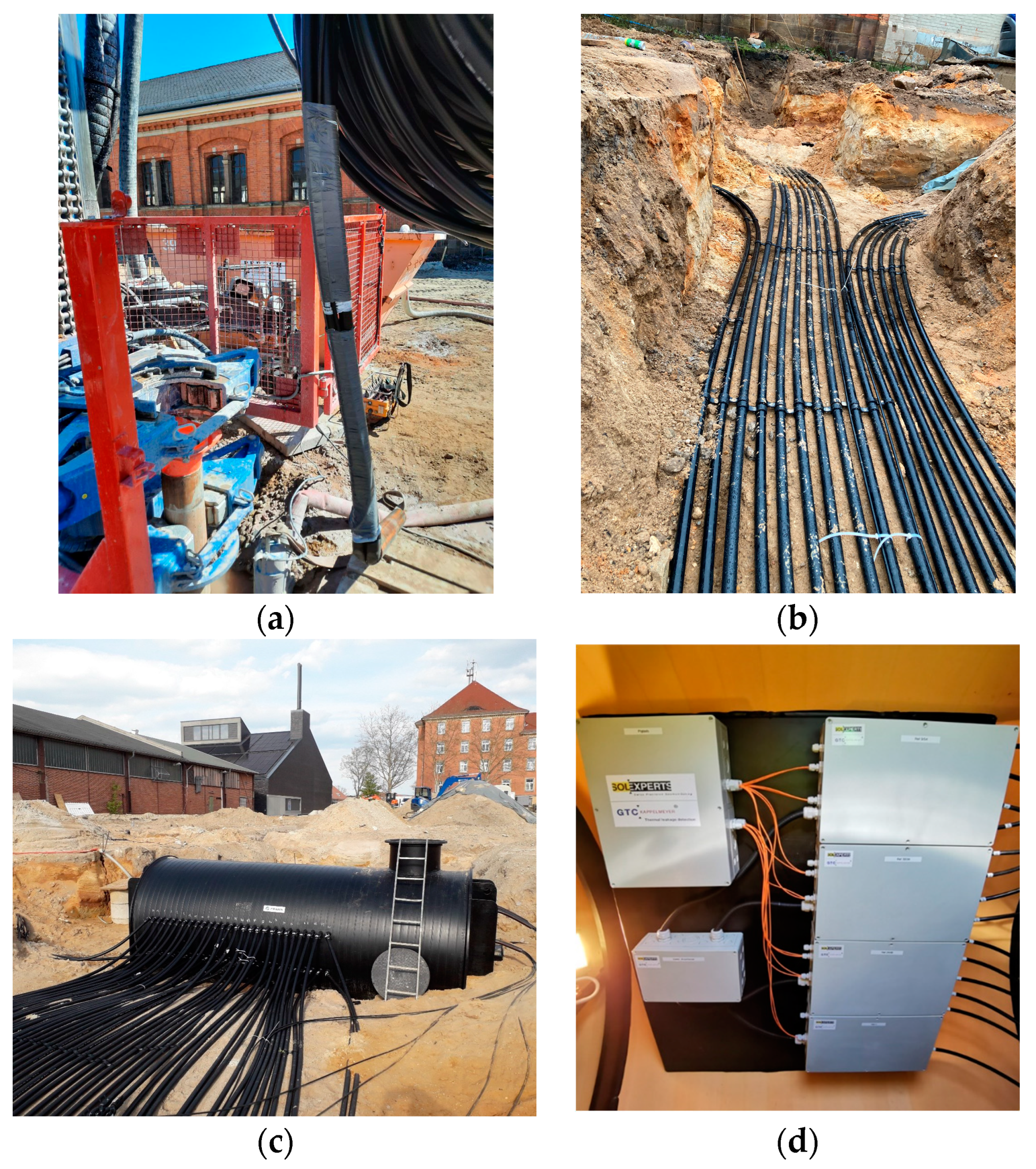
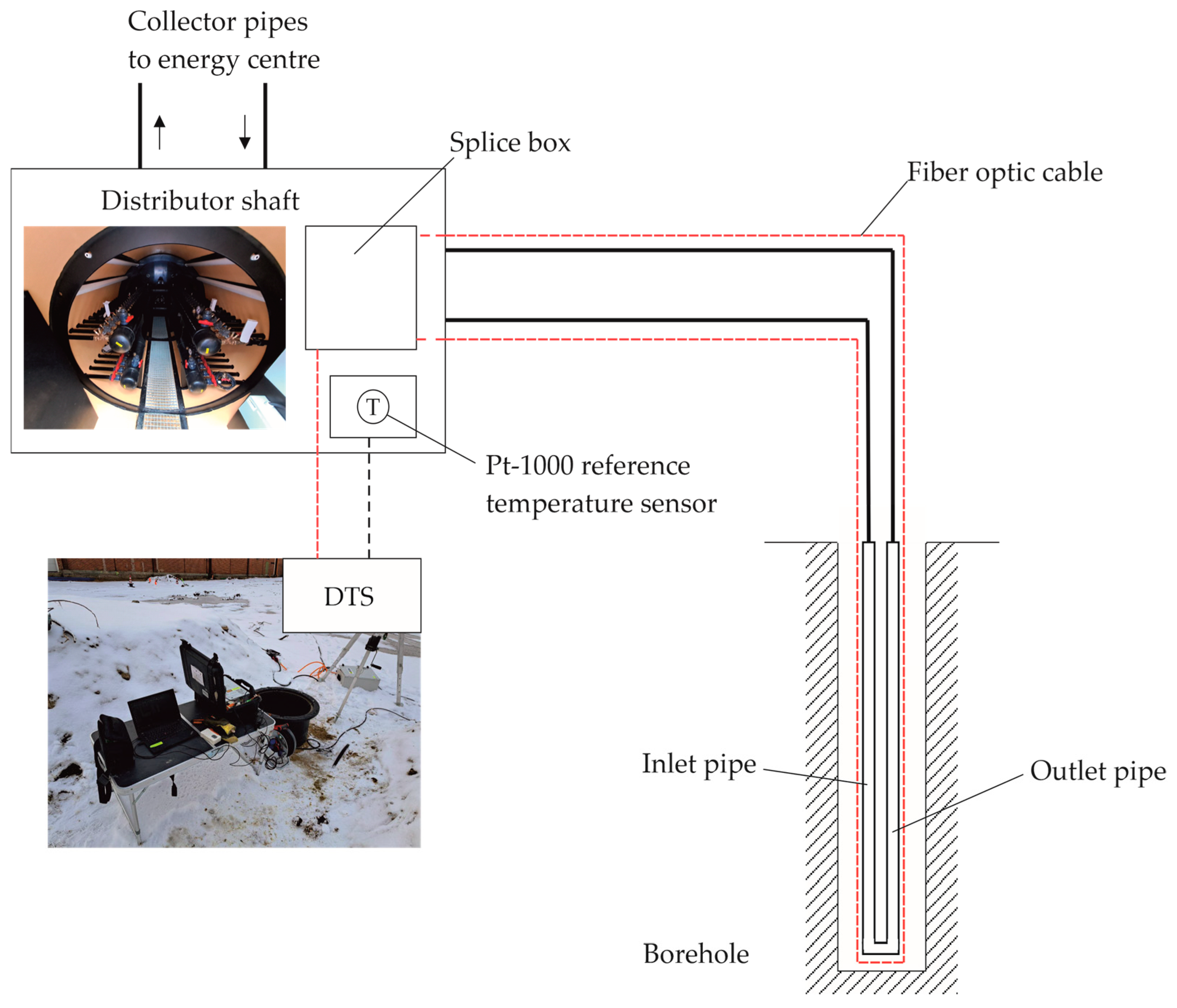

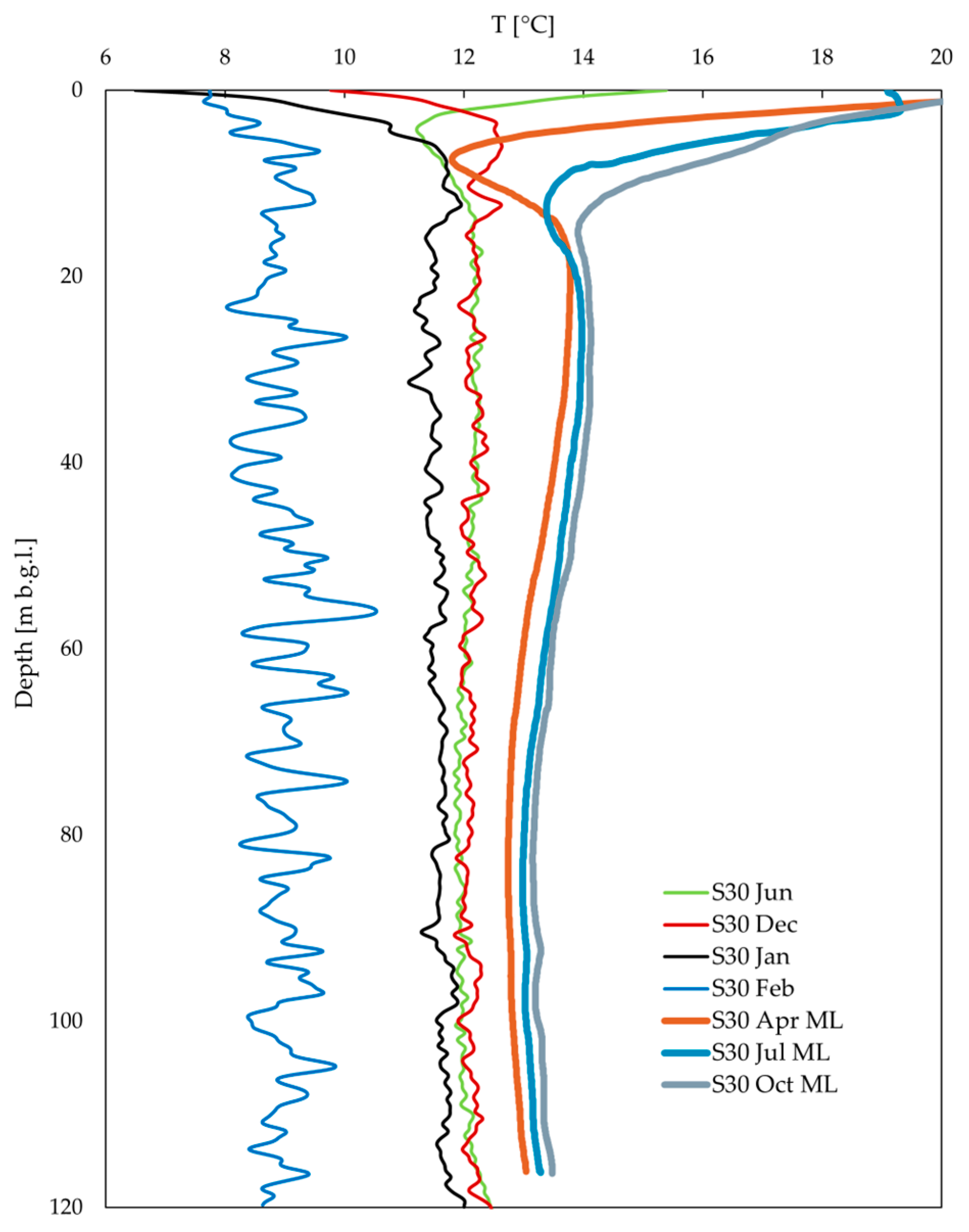
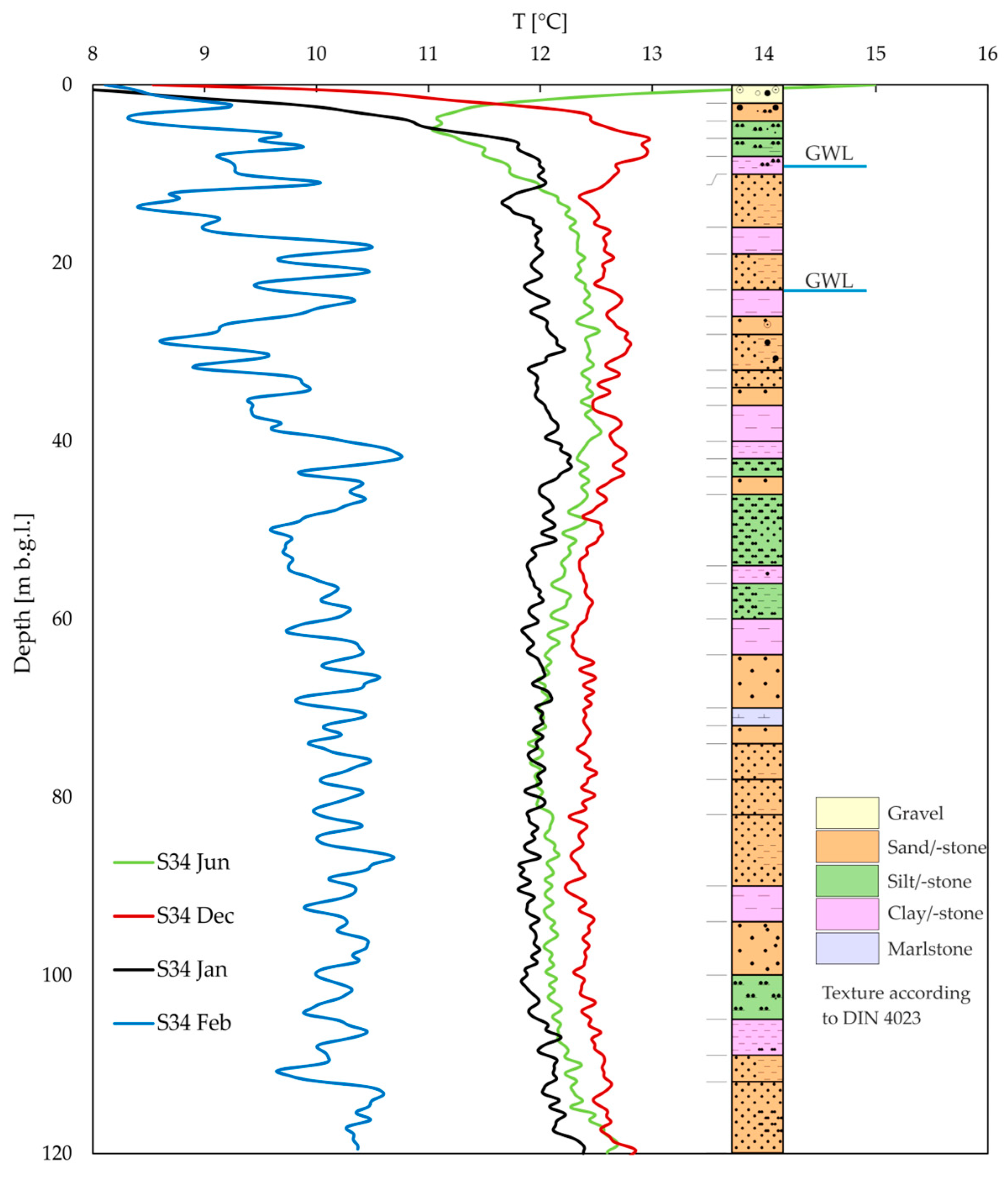
| DTS Device | Parameters |
|---|---|
| Distance measurement range | 2 km |
| Temperature resolution | Single-ended 0.05 °C |
| Dual-ended (loop) 1 0.04 °C | |
| Minimum sampling interval | 0.15 m |
| Minimum spatial resolution | 0.7 m |
| Temperature repeatability | 0.11 °C |
| Measurement time (this study) | 10 s to 24 h (60 s) |
| Optical connector | E2000 APC 8° angled; |
| 50/125 μm graded index MM | |
| Communication protocol | SCPI; Modbus TCP |
| Power consumption | 21–60 W |
| Optical fiber cable | Parameters |
| Type | Hybrid cable for outdoor use 2 |
| 4 multimode fibers | |
| Diameter | 11 mm ± 0.5 mm |
| Quantity of elements | 1× Tube fiber optic, 4 CU wires |
Disclaimer/Publisher’s Note: The statements, opinions and data contained in all publications are solely those of the individual author(s) and contributor(s) and not of MDPI and/or the editor(s). MDPI and/or the editor(s) disclaim responsibility for any injury to people or property resulting from any ideas, methods, instructions or products referred to in the content. |
© 2024 by the authors. Licensee MDPI, Basel, Switzerland. This article is an open access article distributed under the terms and conditions of the Creative Commons Attribution (CC BY) license (https://creativecommons.org/licenses/by/4.0/).
Share and Cite
Bertermann, D.; Suft, O. Determination of the Temperature Development in a Borehole Heat Exchanger Field Using Distributed Temperature Sensing. Energies 2024, 17, 4697. https://doi.org/10.3390/en17184697
Bertermann D, Suft O. Determination of the Temperature Development in a Borehole Heat Exchanger Field Using Distributed Temperature Sensing. Energies. 2024; 17(18):4697. https://doi.org/10.3390/en17184697
Chicago/Turabian StyleBertermann, David, and Oliver Suft. 2024. "Determination of the Temperature Development in a Borehole Heat Exchanger Field Using Distributed Temperature Sensing" Energies 17, no. 18: 4697. https://doi.org/10.3390/en17184697
APA StyleBertermann, D., & Suft, O. (2024). Determination of the Temperature Development in a Borehole Heat Exchanger Field Using Distributed Temperature Sensing. Energies, 17(18), 4697. https://doi.org/10.3390/en17184697







